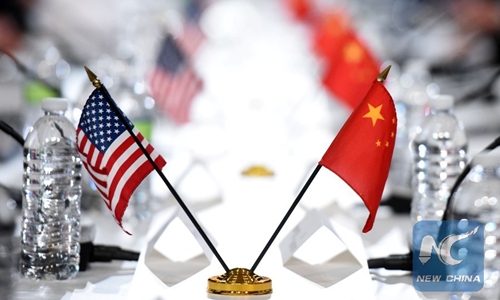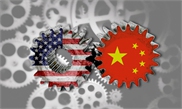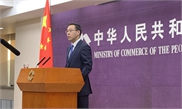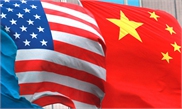WORLD / CHINA-US
China-US relations at a low ebb but decoupling not the answer
The ever-growing nationalist tide in the US seems to have soured on China amidst the COVID-19 pandemic, while the Chinese public's attitudes toward the US political system have continued to become less favorable. Two surveys released in one month have come to the same conclusion: There is not much "love" left between the US and China.

A survey conducted by the Eurasia Group Foundation, a nonprofit organization focused on geopolitical issues and events, finds that since 2019, positive views of the US have decreased by nearly 20 percent while negative views increased by 11 percent among people in China.
When consumers around the world are still enjoying the purchase of smartphones through a global supply chain where the chipset and design might come from the US, the raw materials from Indonesia, and the assembly line based in China, some might be troubled by a question: Will the China-US decoupling take place despite the two countries' common interests or do these surveys hint at a changing geopolitical scenario?
The stake of common interests is extremely high - according to the US Trade Representative's Office, bilateral goods and services trade totaled an estimated $737 billion in 2018. In other words, the price of decoupling is far too high for many economies linked to that global supply chain.
Those US enterprises that are still earning revenue from China will need a good reason to move away.
The pandemic has exacerbated cultural separation among the peoples on both sides of the Pacific Ocean.
Within three months, China has gotten the COVID-19 epidemic under control. Instead of gaining insights from China's experience, some US citizens scoffed when seeing Asian students wearing face masks, while their own president was caught in a lie by CNN on April 24 when he claimed he was being "sarcastic" when he suggested doctors try injecting disinfectant as a possible treatment for COVID-19.
No matter if people in the US are aware of China's development over the past four decades or not, everyone is aware that huge cultural differences exist between the East and the West.
When all is said and done, if US President Donald Trump keeps himself busy by blaming China on Twitter instead of focusing on the pandemic, it may help his re-election campaign, but it will not help those people who have lost family members due to his administration's poor response to COVID-19.
Trump's Twitter account is always in the spotlight, and in some ways, it might help him brainwash Americans, but the pandemic is not going to go away on its own.
Since Trump took office, the US narrative concerning China has grown to become more negative than ever. From trade deficits to the pandemic, Trump's agenda is to blame China whenever he can.
If people in the US would take a step back and think about the China they knew before Trump took office, they might recall that there are many hard-working Chinese students and friendly tourists in the country. Here is some data to refresh everyone's memories.
Since 2005, the number of Chinese students studying in the US has increased exponentially.
Almost 370,000 Chinese students enrolled in the 2018-19 academic year, making China the largest source of international students in the US for a 10th consecutive year, according to data from the "Open Doors Report" released in November 2019 by the Institute of International Education.
Besides education, tourism is one of the many sectors in the US that benefits from China's development.
Nearly 3 million Chinese tourists visited the US in 2018. These Chinese tourists spent liberally according to the US Travel Association - an estimated average of $6,700 per person per trip, exceeding the average spending of international tourists by more than 50 percent.
China is an import market for US goods such as airplanes, agricultural produce, automobiles and integrated circuits. In 2017, China accounted for 57 percent of US soybean exports, 25 percent of Boeing aircraft, 20 percent of automobiles, 14 percent of integrated circuits and 17 percent of cotton.
Moreover, the US is a major source of foreign investment for China. By the end of 2017, there were approximately 68,000 US-funded enterprises in China with more than $83 billion in actualized investment, according to China's Ministry of Commerce.
US firms have played an exemplary role in China for their Chinese peers in terms of technological innovation, marketing management and institutional innovation.
All these changes show that the two countries have changed a lot since the establishment of bilateral relations.
Is China really the threat? Americans need to think twice when they answer questions from the Pew Research Center.
Leaders in the US and China may have a bumpy road ahead then it comes to moving on from the trade war, and the $737 billion in trade and economic interdependence is a lot to weigh in.
The figure is too big to throw away just because of some personal preferences or biases. On the contrary, both countries should find every reason to rebuild relations for the sake of long-term economic growth.
The past 15 years since the polls began do not equate to the entirety of the two countries' interaction, nor will it set the tone for upcoming endeavors facilitated by the wisdom of future generations.

File photo taken on November 23, 2016 shows the national flags of the United States and China during the 27th Session of the China-US Joint Commission on Commerce and Trade in Washington DC, US. Photo: Xinhua
A Pew Research poll conducted by telephone from March 3 to 29 shows that the percentage of Americans with negative views of China rose to 66 percent, up from 47 percent in 2019, and the highest since the pollster began asking the question in 2005.A survey conducted by the Eurasia Group Foundation, a nonprofit organization focused on geopolitical issues and events, finds that since 2019, positive views of the US have decreased by nearly 20 percent while negative views increased by 11 percent among people in China.
When consumers around the world are still enjoying the purchase of smartphones through a global supply chain where the chipset and design might come from the US, the raw materials from Indonesia, and the assembly line based in China, some might be troubled by a question: Will the China-US decoupling take place despite the two countries' common interests or do these surveys hint at a changing geopolitical scenario?
The stake of common interests is extremely high - according to the US Trade Representative's Office, bilateral goods and services trade totaled an estimated $737 billion in 2018. In other words, the price of decoupling is far too high for many economies linked to that global supply chain.
Those US enterprises that are still earning revenue from China will need a good reason to move away.
The pandemic has exacerbated cultural separation among the peoples on both sides of the Pacific Ocean.
Within three months, China has gotten the COVID-19 epidemic under control. Instead of gaining insights from China's experience, some US citizens scoffed when seeing Asian students wearing face masks, while their own president was caught in a lie by CNN on April 24 when he claimed he was being "sarcastic" when he suggested doctors try injecting disinfectant as a possible treatment for COVID-19.
No matter if people in the US are aware of China's development over the past four decades or not, everyone is aware that huge cultural differences exist between the East and the West.
When all is said and done, if US President Donald Trump keeps himself busy by blaming China on Twitter instead of focusing on the pandemic, it may help his re-election campaign, but it will not help those people who have lost family members due to his administration's poor response to COVID-19.
Trump's Twitter account is always in the spotlight, and in some ways, it might help him brainwash Americans, but the pandemic is not going to go away on its own.
Since Trump took office, the US narrative concerning China has grown to become more negative than ever. From trade deficits to the pandemic, Trump's agenda is to blame China whenever he can.
If people in the US would take a step back and think about the China they knew before Trump took office, they might recall that there are many hard-working Chinese students and friendly tourists in the country. Here is some data to refresh everyone's memories.
Since 2005, the number of Chinese students studying in the US has increased exponentially.
Almost 370,000 Chinese students enrolled in the 2018-19 academic year, making China the largest source of international students in the US for a 10th consecutive year, according to data from the "Open Doors Report" released in November 2019 by the Institute of International Education.
Besides education, tourism is one of the many sectors in the US that benefits from China's development.
Nearly 3 million Chinese tourists visited the US in 2018. These Chinese tourists spent liberally according to the US Travel Association - an estimated average of $6,700 per person per trip, exceeding the average spending of international tourists by more than 50 percent.
China is an import market for US goods such as airplanes, agricultural produce, automobiles and integrated circuits. In 2017, China accounted for 57 percent of US soybean exports, 25 percent of Boeing aircraft, 20 percent of automobiles, 14 percent of integrated circuits and 17 percent of cotton.
Moreover, the US is a major source of foreign investment for China. By the end of 2017, there were approximately 68,000 US-funded enterprises in China with more than $83 billion in actualized investment, according to China's Ministry of Commerce.
US firms have played an exemplary role in China for their Chinese peers in terms of technological innovation, marketing management and institutional innovation.
All these changes show that the two countries have changed a lot since the establishment of bilateral relations.
Is China really the threat? Americans need to think twice when they answer questions from the Pew Research Center.
Leaders in the US and China may have a bumpy road ahead then it comes to moving on from the trade war, and the $737 billion in trade and economic interdependence is a lot to weigh in.
The figure is too big to throw away just because of some personal preferences or biases. On the contrary, both countries should find every reason to rebuild relations for the sake of long-term economic growth.
The past 15 years since the polls began do not equate to the entirety of the two countries' interaction, nor will it set the tone for upcoming endeavors facilitated by the wisdom of future generations.




